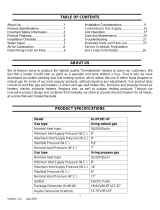
2
Do not place clothing or other flammable
material on or near the appliance. Never
place any objects on the heater.
TABLE OF CONTENTS
Safety Information ........................................................2
Local Codes ..................................................................3
Unpacking .....................................................................4
Product Features ............................................................4
Qualified Installation Agency .......................................4
Air For Combustion and Ventilation ............................4
Installation .....................................................................7
Operating Log Set .......................................................13
Inspecting Burners ......................................................
Cleaning and Maintenance ..........................................18
Troubleshooting ..........................................................19
Specifications ..............................................................22
Parts List and Illustrated Parts Breakdown .................
Warranty Information ..................................Back Cover
SAFETY INFORMATION
DANGER: Carbon monoxide poisoning
may lead to death!
Carbon Monoxide Poisoning: Early signs of carbon
monoxide poisoning resemble the flu, with headaches, diz-
ziness, and/or nausea. If you have these signs, heater may
not be working properly.
Get fresh air at once! Have
heater serviced. Some people–pregnant women, persons
with heart or lung disease, anemia, those under the influ-
ence of alcohol, those at high altitudes–are more affected
by carbon monoxide than others.
Propane/LP Gas: Propane/LP gas is odorless. An odor-
making agent is added to the gas. The odor helps you detect
a gas leak. However, the odor added to the gas can fade.
Gas may be present even though no odor exists.
Make certain you read and understand all warnings. Keep
this manual for reference. It is your guide to safe and proper
operation of this appliance.
WARNING: Any change to this heater
or its controls can be dangerous.
WARNING: Do not allow fans to blow
directly into the appliance. Avoid any drafts
that alter burner flame patterns. Ceiling
fans can create drafts that alter burner
flame patterns. Altered burner patterns can
cause sooting.
WARNING: Do not use a blower insert,
heat exchanger insert, or other accessory
not approved for use with this appliance.
Due to high temperatures, the appliance
should be located out of traffic and away
from furniture and draperies.
WARNING: Improper installation, adjust-
ment, alteration, service, or maintenance
can cause injury or property damage. Refer
to this manual for correct installation and
operational procedures. For assistance or
additional information consult a qualified
installer, service agency, or the gas sup-
plier.
Carefully supervise young children when
they are in the room with fireplace.
Fireplace front and screen become very
hot when running appliance. Keep chil-
dren and adults away from hot surfaces to
avoid burns or clothing ignition. Logs will
remain hot for a time after shutdown. Allow
surfaces to cool before touching.
You must operate this heater with the fire-
place screen in place. Make sure the fireplace
screen is in place before funning this app-
liance.
Unless other provisions are made for comb-
ustion air, the screens shall have an opening
or openings for introduction of combustion
air into the fireplace
If this appliance is installed in a fireplace that
has glass doors, the doors must be left open
when the appliance is in use.
WARNING: This product contains and/or
generates chemicals known to the state of
California to cause cancer or birth defects
or other reproductive harm.
18
24





















